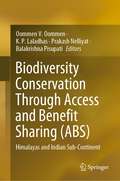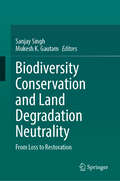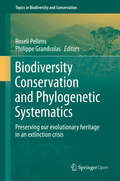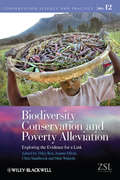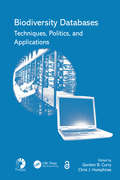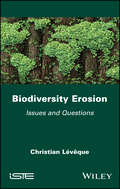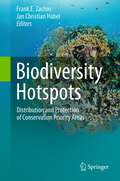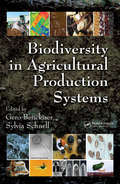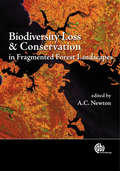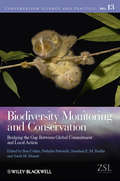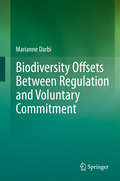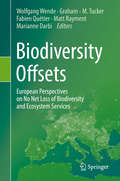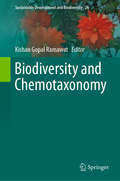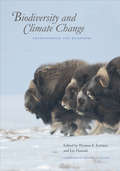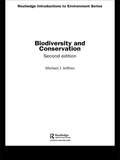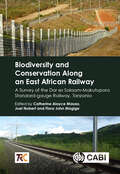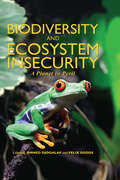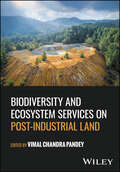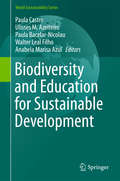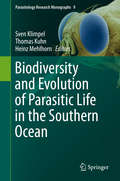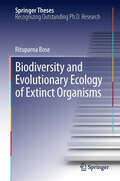- Table View
- List View
Biodiversity Conservation Through Access and Benefit Sharing (ABS): Himalayas and Indian Sub-Continent
by K. P. Laladhas Oommen V. Oommen Prakash Nelliyat Balakrishna PisupatiThis book deals with the economic potentials of biodiversity and its capacity to support its own conservation aiming to provide livelihood for millions engaged in conservation, both now and for future generations. The book highlights the potentials of natural resources which are characterized as capital wealth (as defined in Convention on Biological Diversity (CBD)), to finance its own conservation and to provide livelihood means to people who conserve it.The book is divided into five Parts. PART I explains about the Premise of Access and Benefit Sharing (ABS), PART II describes about the Technology Transfer, PART III will provide details about the Access to Genetic Resources and to Associated Traditional Knowledge and Benefit Sharing PART IV is the Implementation of ABS Mechanisms and PART V is about ABS and Its Economics.This book will be of interest to biodiversity policy makers, administrators, university and college students, researchers, biodiversity conservationists.
Biodiversity Conservation and Land Degradation Neutrality: From Loss to Restoration
by Sanjay Singh Mukesh K. GautamThis book highlights various issues related to biodiversity conservation and land degradation, and the global challenges faced in achieving land degradation neutrality. It then discusses the importance of ecosystem restoration as a pivotal strategy in solving these issues. Ecosystem diversity and its health directly influence land productivity and its range of ecosystem services. Achieving land degradation neutrality is crucial for restoring and reinforcing biodiversity's structure and function, which ultimately plays vital role in building climate resilience. To substantiate these ideas, this book presents practical case studies and exemplifies best practices in plant, animal and ecosystem conservation. It prominently highlights the intricate interplay of complex drivers behind land use, land use change, and land degradation. It also examines the direct consequences of land degradation on biodiversity and explore global efforts, frameworks, and strategies crucial for achieving land degradation neutrality. Furthermore, it integrates indigenous knowledge, policy framework and community engagement as instrumental components for achieving global targets related to sustainable land management. This book accentuates the significance of terrestrial ecosystems in achieving biodiversity goals outlined in SDG 15, Life on Land, through a multidisciplinary approach and contributions from academicians, policymakers, United Nations Organizations, and subject matter specialists. Thus, it is a resource for students, trainees, and researchers, providing them with knowledge and insights about significance of land degradation, land degradation neutrality, and biodiversity conservation.
Biodiversity Conservation and Phylogenetic Systematics: Preserving our evolutionary heritage in an extinction crisis (Topics in Biodiversity and Conservation #14)
by Roseli Pellens Philippe GrandcolasThis book is about phylogenetic diversity as an approach to reduce biodiversity losses in this period of mass extinction. Chapters in the first section deal with questions such as the way we value phylogenetic diversity among other criteria for biodiversity conservation; the choice of measures; the loss of phylogenetic diversity with extinction; the importance of organisms that are deeply branched in the tree of life, and the role of relict species. The second section is composed by contributions exploring methodological aspects, such as how to deal with abundance, sampling effort, or conflicting trees in analysis of phylogenetic diversity. The last section is devoted to applications, showing how phylogenetic diversity can be integrated in systematic conservation planning, in EDGE and HEDGE evaluations. This wide coverage makes the book a reference for academics, policy makers and stakeholders dealing with biodiversity conservation.
Biodiversity Conservation and Poverty Alleviation: Exploring the Evidence for a Link (Conservation Science and Practice)
by Matt Walpole Dilys Roe Chris Sandbrook Joanna ElliottBiodiversity conservation and poverty alleviation are both important societal goals demanding increasing international attention. While they may seem to be unrelated, the international policy frameworks that guide action to address them make an explicit assumption that conserving biodiversity will help to tackle global poverty. Part of the Conservation Science and Practice Series published with the Zoological Society of London, this book explores the validity of that assumption. The book addresses a number of critical questions: Which aspects of biodiversity are of value to the poor? Does the relationship between biodiversity and poverty differ according to particular ecological conditions? How do different conservation interventions vary in their poverty impacts? How do distributional and institutional issues affect the poverty impacts of interventions? How do broader issues such as climate change and the global economic system affect the biodiversity – poverty relationship at different scales? This volume will be of interest to policy-makers, practitioners and researchers concerned with understanding the potential - and limitations - of integrated approaches to biodiversity conservation and poverty alleviation.
Biodiversity Databases: Techniques, Politics, and Applications
by Gordon B. CurryWith changes in technology and a renewed effort to catalog the world's biodiversity, huge amounts of data are being generated on biodiversity issues. As response to the call for better information systems to manage the biodiversity crisis, a wide range of solutions are being developed for inventorying, managing, and disseminating taxonomic data. This book brings together a diverse array of authors, expertise, and assessors that discuss technical developments to improve the construction, population, and dissemination of biodiversity information. It is designed to inform students and researchers of biodiversity about the changes and challenges that need to be understood by everyone in this information age.
Biodiversity Erosion: Issues and Questions
by Christian LévêqueThe erosion of biodiversity is currently highly publicized. Militant movements accuse humans of destroying nature and being responsible for a sixth mass extinction. However, this anxiety-provoking message is sometimes based on misconceptions, false or partisan ideas, and media relays that favor and amplify alarmist information. If the situation of certain populations is worrying, it is not a general phenomenon because others are expanding. Rather than holding a globalizing discourse, it is necessary to recontextualize and relativize the debate to better define the necessary actions.Biodiversity Erosion analyzes numerous scientific publications, as well as alarming discussions, emphasizing the multiple biases present in the way information is presented. This book questions the relevance of the notion of species and the desire to compile an inventory of all living things. It argues for a less Manichean approach to our relationship with nature.
Biodiversity Hotspots: Distribution and Protection of Conservation Priority Areas
by Jan Christian Habel Frank E. ZachosBiodiversity and its conservation are among the main global topics in science and politics and perhaps the major challenge for the present and coming generations. This book written by international experts from different disciplines comprises general chapters on diversity and its measurement, human impacts on biodiversity hotspots on a global scale, human diversity itself and various geographic regions exhibiting high levels of diversity. The areas covered range from genetics and taxonomy to evolutionary biology, biogeography and the social sciences. In addition to the classic hotspots in the tropics, the book also highlights various other ecosystems harbouring unique species communities including coral reefs and the Southern Ocean. The approach taken considers, but is not limited to, the original hotspot definition sensu stricto and presents a chapter introducing the 35th hotspot, the forests of East Australia. While, due to a bias in data availability, the majority of contributions on particular taxa deal with vertebrates and plants, some also deal with the less-studied invertebrates. This book will be essential reading for anyone involved with biodiversity, particularly researchers and practitioners in the fields of conservation biology, ecology and evolution.
Biodiversity II: Understanding and Protecting Our Biological Resources
by Edward O. Wilson Don E. Wilson Marjorie L. Reaka-KudlaThe book before you . . . carries the urgent warning that we are rapidly altering and destroying the environments that have fostered the diversity of life forms for more than a billion years.With those words, Edward O. Wilson opened the landmark volume Biodiversity (National Academy Press, 1988). Despite this and other such alarms, species continue to vanish at a rapid rate, taking with them their genetic legacy and potential benefits. Many disappear before they can even be identified.Biodiversity II is a renewed call for urgency. This volume updates readers on how much we already know and how much remains to be identified scientifically. It explores new strategies for quantifying, understanding, and protecting biodiversity, including New approaches to the integration of electronic data, including a proposal for a U.S. National Biodiversity Information Center.Application of techniques developed in the human genome project to species identification and classification.The Gap Analysis Program of the National Biological Survey, which uses layered satellite, climatic, and biological data to assess distribution and better manage biodiversity.The significant contribution of museum collections to identifying and categorizing species, which is essential for understanding ecological function and for targeting organisms and regions at risk. The book describes our growing understanding of how megacenters of diversity (e.g., rainforest insects, coral reefs) are formed, maintained, and lost; what can be learned from mounting bird extinctions; and how conservation efforts for neotropical primates have fared. It also explores ecosystem restoration, sustainable development, and agricultural impact.Biodiversity II reinforces the idea that the conservation of our biological resources is within reach as long as we pool resources; better coordinate the efforts of existing institutions--museums, universities, and government agencies--already dedicated to this goal; and enhance support for research, collections, and training. This volume will be important to environmentalists, biologists, ecologists, educators, students, and concerned individuals.
Biodiversity In Agricultural Production Systems (Books in Soils, Plants, and the Environment)
by Gero Benckiser Sylvia SchnellWhile modern science has always recognized the central role that biodiversity plays in the ecological processes that maintain the Earth's equilibrium, our increasing knowledge of nature has deepened our appreciation of this principle. Consequently, those involved with implementing and maintaining sustainable agriculture systems have begun to take a
Biodiversity Islands: Strategies for Conservation in Human-Dominated Environments (Topics in Biodiversity and Conservation #20)
by Florencia MontagniniThis book is intended to provide an overview for the identification and establishment of biodiversity islands. It presents examples and case studies where the biodiversity islands approach is being used in a variety of locations and contexts worldwide. It will contribute to design parameters on appropriate sizing and spatial distribution of biodiversity islands in order to be effective in conservation and regeneration across the landscape, using integrated landscape management approaches. This book is essential given the current worldwide trend of habitat destruction and the need to preserve biodiversity and its values. The chapters are organized in five sections. The first section provides the introduction. Section 2,3 and 4 discuss the challenges and alternatives of establishment and management, case studies across the globe, safeguarding of the environmental, economic, and social benefits, and the final section offers a conclusion. The contributing authors present views from the academic, the practitioner and the policymaker perspectives, offering alternatives and suggestions for promoting strategies that support biodiversity conservation through intentionally designed frameworks for sustainable forest landscapes. Readers will discover suggestions and concrete examples that can be used by a variety of stakeholders in various settings throughout the world. This book is useful to researchers, farmers, foresters, landowners, land managers, city planners, and policy makers alike.
Biodiversity Loss and Conservation in Fragmented Forest Landscapes: Evidence from Tropical Montane and South Temperate Rain Forests in Latin America
by A. C. NewtonThe studies reported allow for comparative analysis across areas and help identify how human disturbance has impacted the biodiversity of all forest types. Chapters incorporate features of landscape ecology, floristic biodiversity, conservation and policy and vary from in-depth investigations of a single study area to integrated examinations across regions.
Biodiversity Monitoring and Conservation: Bridging the Gap Between Global Commitment and Local Action (Conservation Science and Practice)
by Nathalie Pettorelli Ben Collen Sarah M. Durant Jonathan E. M. BaillieAs the impacts of anthropogenic activities increase in both magnitude and extent, biodiversity is coming under increasing pressure. Scientists and policy makers are frequently hampered by a lack of information on biological systems, particularly information relating to long-term trends. Such information is crucial to developing an understanding as to how biodiversity may respond to global environmental change. Knowledge gaps make it very difficult to develop effective policies and legislation to reduce and reverse biodiversity loss. This book explores the gap between global commitments to biodiversity conservation, and local action to track biodiversity change and implement conservation action. High profile international political commitments to improve biodiversity conservation, such as the targets set by the Convention on Biological Diversity, require innovative and rapid responses from both science and policy. This multi-disciplinary perspective highlights barriers to conservation and offers novel solutions to evaluating trends in biodiversity at multiple scales.
Biodiversity Offsets Between Regulation and Voluntary Commitment: A Typology of Approaches Towards Environmental Compensation and No Net Loss of Biodiversity
by Marianne DarbiWe are witnessing an alarming, global biodiversity crisis with an ongoing loss of species and their habitats. In response, a number of tools and approaches – including some that are contested – are being explored and promoted. Biodiversity offsets are one such approach, and deserve critical examination since the debate surrounding them has often been oversimplified and lacking practical evidence. As such, this study presents a refined typology including seven types of biodiversity offsets and taking into account different contexts, governance arrangements and drivers. It draws on a detailed analysis of theoretical concepts to explain the voluntary implementation of biodiversity offsets using an internet-based (netnographic) research approach. Furthermore it builds on a broad global explorative base of 72 practical examples and presents in-depth case studies for each type. The results reveal a number of global tendencies that allow recommendations to be made for different locations, contexts and stakeholders. They also encourage the expansion of this research field to respond to the pressing needs of policy and practice.
Biodiversity Offsets: The European Perspective On No Net Loss Of Biodiversity And Ecosystem Services
by Wolfgang Wende Fabien Quétier Matt Rayment Marianne Darbi Graham TuckerThis book deals with the new concept of biodiversity offsets. The aim of offsetting schemes is to achieve no let loss or even net gain of biodiversity. Offsets obey a mitigation hierarchy and reflect the precautionary and polluter-pays principle in regard to project impacts. Readers gain insights into current debates on biodiversity policies, with top experts outlining theoretical principles and the latest research findings. At the same time the focus is on practical application and case studies. Today there is a lively international discussion among practitioners and scientists on the optimal legal framework, metrics and design of habitat banks to ensure the success of biodiversity offsets and to minimise the risks of failure or misuse. Contributing to the debate, this volume presents the activities and practices of biodiversity offsetting already implemented in Europe in selected EU member states, and the lessons that can be learnt from them. Readers may be surprised at how much experience already exists in these countries. A further aim of the book is to offer grounded insights on the road ahead, and foster a more intensive and fruitful discussion on how offsetting can be extended and improved upon, so that it becomes a key and effective component of Europe’s biodiversity conservation policy framework.
Biodiversity and Business: Bio Prospecting and Benefit Sharing
by Oommen V. Oommen Prakash Nelliyat Laladhas Krishna PanickerThis book addresses the climate risk influencing biodiversity globally and discusses the sustainable use of biological diversity and its legal implications. The sustainable bio-prospecting will help conservation regarding the resources and livelihood support of those who conserve it from the UN CBD perspective. In mega bio-diverse countries, biodiversity provides a number of ecosystem services as well as sources of income/livelihood for millions of poor and they are also the home of a vast repository of traditional knowledge (TK) associated with biological resources which can be translated therapeutically. As for Climate risks, the risks related to unscientific management and use of biodiversity are far more compared to the benefits for society and business and therefore, reducing pressure on biodiversity and developing a sustainable commodity supply chain is essential for both the industry and the governments. Exploring and further mining of the vastness of biodiversity potential, in the marketplace, has been a subject of great consideration among biotechnologists, food processors, health care specialists and the like, as they are real money-spinners. The book will be of interest to researchers/College/ University students interested in ecology and biodiversity conservation worldwide
Biodiversity and Chemotaxonomy (Sustainable Development and Biodiversity #24)
by Kishan Gopal RamawatPlant classifications are based on morphological characters and it is difficult, particularly in small plants and grasses, to identify these below generic level on the basis of these characters using a dissecting microscope. Plant species have intra- and inter-specific variation in secondary metabolites which can be utilized as marker compounds for identification and classification of plants. Secondary metabolites are produced as a result of primary metabolism and the production of these compounds not only involves several genes but also it is an energy dependent process. Hence these products cannot be considered as insignificant for the plant and the environment. Modern tools of molecular biology and secondary metabolites present in them can definitively decide about classification of plants. Absence of correct identification of plant is associated to many problems of resource utilization. Due to wide availability of these tools, interest has revived in systematics and correct classification of plants based on these parameters for their sustainable utilization and resource management. The purpose of this book is to assess the potential of phytochemical and molecular tools in the systematic and classification of plants. The topics covered include species concept, barcoding and phylogenetic analysis, chemotaxonomy use of polyketides, carotenes, cuticular wax, volatile oils, biodiversity of corals, metazoans, Ruta and Echinocereus. It provides comprehensive and broad subject-based reviews, useful for students, teachers, researchers, and all others interested in the field. The field has been kept wide and general to accommodate the wide-ranging topics. This book will be useful to agriculturists, chemists, botanists, industrialists, and those involved in planning of crop plants.
Biodiversity and Climate Change: Transforming the Biosphere
by Edward O. Wilson Thomas E. Lovejoy Lee HannahAn essential, up-to-date look at the critical interactions between biological diversity and climate change that will serve as an immediate call to action The physical and biological impacts of climate change are dramatic and broad‑ranging. People who care about the planet and manage natural resources urgently need a synthesis of our rapidly growing understanding of these issues. In this all‑new sequel to the 2005 volume Climate Change and Biodiversity, leading experts in the field summarize observed changes, assess what the future holds, and offer suggested responses. From extinction risk to ocean acidification, from the future of the Amazon to changes in ecosystem services, and from geoengineering to the power of ecosystem restoration, this book captures the sweep of climate change transformation of the biosphere.
Biodiversity and Conservation
by Michael J. JeffriesThis revised second edition provides an introductory guide through the maze of interdisciplinary themes that comprise 'biodiversity.' It combines biological sciences with insights into the origins, variety and distribution of biodiversity, analysis of the social and political context, and the threats to, and opportunities for, the survival of natural systems. Whilst retaining its existing structure, this updated new edition reflects advances that have demonstrated the importance of living systems as drivers of environmental services vital to human health and security. The final chapter has been revised to tackle more explicitly the contrasting approaches to conservation, and throughout, the book has been updated to reflect new research and developments. With highly original international case studies and ample illustrations to explain difficult topics clearly, this excellent book remains the only introductory text which brings together the full range of theory and practice of ‘biodiversity’ and ‘conservation’.
Biodiversity and Conservation Along an East African Railway: A Survey of the Dar es Salaam-Makutupora Standard-gauge Railway, Tanzania
by N A Mbwambo Edmond Alavaisha S. Zainabu Bungwa Philbert Anitha Byabato Deusdedith Fidelis Elikana John Jasson John Julius Mohamed Kibaja Heriel Moshy Athumani Fatina Mturi R. Juma Mwangi Henry Ndangalasi Wilrik Ngalasoni Alberto Bruno Nyundo Chacha Werema Felix A. ShayoIt is well known that infrastructure development projects can boost the economy and reduce the cost of trade in both developing and developed economies, however, infrastructure projects can also cause biodiversity loss. This book is the result of an important biodiversity survey conducted along an East African railway in Tanzania. The building of the railway, still under construction, has already led to habitat loss, habitat degradation and landscape change which may have affected biodiversity. The book includes recommendations to mitigate the effect of railway construction by protecting biodiversity and ecosystem services which could have major implications across Africa and other regions. The area covered by the survey focuses on the Standard Gauge Railway (SGR) running through the Pugu and Ruvu South Forest Reserves towards Maktupora-Dodoma, plus data on large mammals through to Isaka-Shinyanga. The Pugu forests boast high biodiversity of both flora and fauna, some of which are endemic to the area. There are both plant and animal species that are of major conservation concern so there is urgent need to consolidate information to help formulate suitable conservation measures. The data collected covers plants, invertebrates, amphibians, birds, and mammals for terrestrial and aquatic environments along the SGR. This work is timely as there are many more ongoing SGR construction projects in Tanzania and across Africa, as such construction activities inevitably involve some habitat modification and destruction that may have a negative impact on biodiversity. National and international scientists, decision and policy makers, as well as ecologists and conservation managers involved in large infrastructure projects will find this book invaluable. The book provides baseline information and can be used as a case study for other infrastructure development projects around the world.
Biodiversity and Conservation of Woody Plants (Sustainable Development and Biodiversity #17)
by M. R. Ahuja S. Mohan JainThis book provides complete, comprehensive, and broad subject-based reviews for students, teachers, researchers, policymakers, conservationists, and NGOs interested in the biodiversity and conservation of woody plants. Forests cover approximately 31 percent of the world's total landmass; 93 percent is natural forest and only 7 percent consists of planted trees. Forest decline is progressing at an alarming rate worldwide. In addition to human activities (logging, deforestation, and exploiting forest lands for agriculture and industrial use), a number of other factors - including pests and diseases, drought, soil acidity, radiation, and ozone - are cumulatively contributing to global forest decline. The present situation forces us to focus on forest conservation strategies for the present and future. Gene conservation and maintaining genetic diversity in forest ecosystems are crucial to the preservation of forest genetic resources. This calls for integrated action to implement both the in situ (on site) preservation of forest stands and ex situ (distant from the original site) strategies for the conservation of woody plants' genetic resources. Selected priority areas include: 1) assessing patterns of genetic diversity and threats, 2) understanding the biological processes regulating genetic diversity, 3) assessing the impact of human activities and climate change on genetic diversity, and 5) finding methods for prioritizing species and populations for the conservation of forest trees genetic resources. All chapters were written by leading scientists in their respective fields, which include: woody plant diversity, ecology and evolution; assessment of genetic diversity in forest tree populations; conservation planning under climate change; and in situ and ex situ strategies, including biotechnological approaches, for the conservation of woody plants genetic resources.
Biodiversity and Ecosystem Insecurity: A Planet in Peril
by Felix Dodds Ahmed DjoghlafBiodiversity and Ecosystem Insecurity provides an authoritative and comprehensive assessment of the threats presented to human security and well-being by the loss of ecosystems and biodiversity recently confirmed as one of the critical 'planetary boundaries' that has already been exceeded. Contributors examine the current trends and state of biodiversity globally, the drivers of biodiversity loss including climate change and economic and population pressures, and the mechanisms and policies needed for conserving and restoring biodiversity in the future. Strong emphasis is placed throughout on the fundamental importance of placing a realistic economic value on nature and the services that ecosystems provide if we are to manage our natural resources successfully; and also on the crucial role of international institutions and government policies achieving this goal. As the recent high-profile meeting of the Convention on Biological Diversity in Nagoya, Japan, underlined, the scale and pace of the destruction of natural habitats and species imperil us all. This volume is an invaluable resource for conservationists, students and those in the private and public sectors concerned to redress the damage being done to the natural world.
Biodiversity and Ecosystem Services on Post-Industrial Land
by Vimal Chandra PandeyGuide to post-industrial site restoration and re-establishment of rich communities of plant species for the provision of key ecosystem services In line with the UN sustainable development goals, Biodiversity and Ecosystem Services on Post-Industrial Land is an expert guide to ecological restoration of post-industrial lands, explaining how to re-introduce biodiversity and ecosystem services by implementing natural processes in the rehabilitation of disturbed sites. It covers both the initial stages associated with the improvement of physicochemical and biological substrate characteristics as a precondition for continuous vegetation, as well as the subsequent re-establishment of rich communities of plant species and how these communities may be optimized for their biodiversity and ecosystem services such as pedogenesis, nutrient cycling, habitation for other organisms, food plants for herbivores, carbon sequestration, and aesthetic value. Case studies of successful restoration of industrial sites from Asia, Africa, North and South America, and Europe, which include coal and mineral mining sites, oil drilling sites, and dumpsites, complement the conceptual part of the text and demonstrate how to put the theory into practice. Written by an experienced researcher in the field, Biodiversity and Ecosystem Services on Post-Industrial Land includes information on: Mining sustainability in arid zones, aromatic plants for phytoremediation, and spontaneous flora growth on metalliferous sites Resilience of plant diversity, ecosystem services from rehabilitated waste dumpsites, and plantation forestry for eco-restoration Soil biodiversity and plant-microbe interactions, afforestation of former asbestos mines, and bauxite mine restoration and management Role of the local government in re-use of sites, restoration of wetlands in oil and gas exploration areas, and carbon sequestration in revegetated coal mine soil Biodiversity and Ecosystem Services on Post-Industrial Land is an essential guide for environmental managers, scientists, ecologists, and engineers tasked with restoring post-industrial sites, managers in mining, oil, gas, and other heavy industries, and NGOs involved in sustainable land use.
Biodiversity and Education for Sustainable Development (World Sustainability Series)
by Walter Leal Filho Ulisses M. Azeiteiro Paula Castro Paula Bacelar-Nicolau Anabela Marisa AzulThis book gathers interdisciplinary reflections fromresearchers, educators, and other experts on the subject of biodiversity closerto education and learning. The book also highlights its role as an added valueto strategic principles for healthy ecosystems and sustainable humandevelopment. It promotes critical thinking and foster practices and attitudesfor Education for Sustainable Development reconciling education with principlesof human behaviour and nature. Readers especially find this book a timelyresource in light of the Strategic Plan for Biodiversity 2011-2020, the AichiTargets, and the new EU biodiversity strategy "Our life insurance, our naturalcapital: an EU biodiversity strategy to 2020". Along with the challenge ofecosystems and public health, biodiversity conservation is essential forhumanity's continued security and sustainability, as it touches on all aspectsof people's lives.
Biodiversity and Evolution of Parasitic Life in the Southern Ocean (Parasitology Research Monographs #9)
by Sven Klimpel Heinz Mehlhorn Thomas KuhnThe Southern Oceans including Antarctic regions are peculiar and very sensitive water biotopes, where animal life and species interrelations are only poorly investigated. Especially the influence of parasites on their host species needs intensive consideration in times of global warming and worldwide pollution. Both factors may influence the finely balanced interrelationships between parasites and endangered hosts especially in specialized regions such as Antarctica. Before this background the present book offers a broad spectrum of important parasite-host interrelations in times of ecosystem changes written by experienced and renown international specialists.
Biodiversity and Evolutionary Ecology of Extinct Organisms (Springer Theses)
by Rituparna BoseIncreasing rate of species extinction in the present day will lead to a huge biodiversity crisis; eventually, this will lead to the paucity of non-renewable resources of energy making our Earth unsustainable in future. To save our mother planet from this crisis, studies need to be performed to discover abundant new fossil sites on Earth for continued access to oil-rich locations. Most importantly, a holistic approach is necessary in solving the present problem of biodiversity loss. This book presents newly developed quantitative models in understanding the biodiversity, evolution and ecology of extinct organisms. This will assist future earth scientists in understanding the natural and anthropogenic causes behind biodiversity crisis and ecosystem collapse. In addition, this study would be of great interest to exploration geologists and geophysicists in potentially unraveling natural resources from our sustainable Earth.
